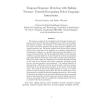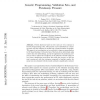1059 search results - page 211 / 212 » Recognition of Fanout-free Functions |
BMCBI
2008
13 years 7 months ago
2008
Background: Detailed information about protein interactions is critical for our understanding of the principles governing protein recognition mechanisms. The structures of many pr...
BMCBI
2007
2007
Application of amino acid occurrence for discriminating different folding types of globular proteins
13 years 7 months ago
Background: Predicting the three-dimensional structure of a protein from its amino acid sequence is a long-standing goal in computational/molecular biology. The discrimination of ...
BMCBI
2006
13 years 7 months ago
2006
Background: In the area of protein structure prediction, recently a lot of effort has gone into the development of Model Quality Assessment Programs (MQAPs). MQAPs distinguish hig...
CONNECTION
2006
13 years 7 months ago
2006
We present an approach for recognition and clustering of spatio temporal patterns based on networks of spiking neurons with active dendrites and dynamic synapses. We introduce a n...
CORR
2006
Springer
13 years 7 months ago
2006
Springer
Fitness functions based on test cases are very common in Genetic Programming (GP). This process can be assimilated to a learning task, with the inference of models from a limited n...


